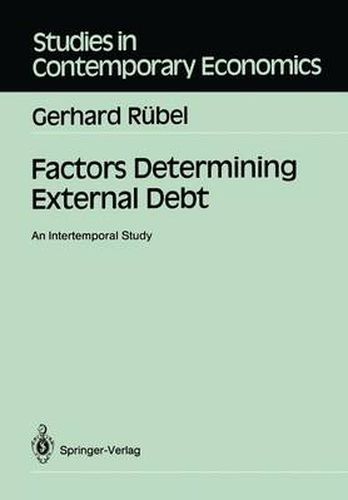Readings Newsletter
Become a Readings Member to make your shopping experience even easier.
Sign in or sign up for free!
You’re not far away from qualifying for FREE standard shipping within Australia
You’ve qualified for FREE standard shipping within Australia
The cart is loading…






This title is printed to order. This book may have been self-published. If so, we cannot guarantee the quality of the content. In the main most books will have gone through the editing process however some may not. We therefore suggest that you be aware of this before ordering this book. If in doubt check either the author or publisher’s details as we are unable to accept any returns unless they are faulty. Please contact us if you have any questions.
Against the background of the international debt problem which originated with the oil shocks of the seventies, this book undertakes a theoretical analysis of the factors determining aggregate external debt, using the example of a raw material importing country. Instead of the usual static definition of the trade balance as the difference between the value of exports and imports in a single period, here an intertemporal approach is used with a country’s current account balance determined as the difference between aggregate saving and aggregate net investment, variables which are primarily dependent on expectations about the future. The analysis is based on microeconomic optimization models which enables individual causal relationships to be presented in a detailed way, the optimal size of external debt to be determined and the desirability of an immediate adjustment in the level of debt following an external disturbance to be shown from a welfare point of view.
$9.00 standard shipping within Australia
FREE standard shipping within Australia for orders over $100.00
Express & International shipping calculated at checkout
This title is printed to order. This book may have been self-published. If so, we cannot guarantee the quality of the content. In the main most books will have gone through the editing process however some may not. We therefore suggest that you be aware of this before ordering this book. If in doubt check either the author or publisher’s details as we are unable to accept any returns unless they are faulty. Please contact us if you have any questions.
Against the background of the international debt problem which originated with the oil shocks of the seventies, this book undertakes a theoretical analysis of the factors determining aggregate external debt, using the example of a raw material importing country. Instead of the usual static definition of the trade balance as the difference between the value of exports and imports in a single period, here an intertemporal approach is used with a country’s current account balance determined as the difference between aggregate saving and aggregate net investment, variables which are primarily dependent on expectations about the future. The analysis is based on microeconomic optimization models which enables individual causal relationships to be presented in a detailed way, the optimal size of external debt to be determined and the desirability of an immediate adjustment in the level of debt following an external disturbance to be shown from a welfare point of view.